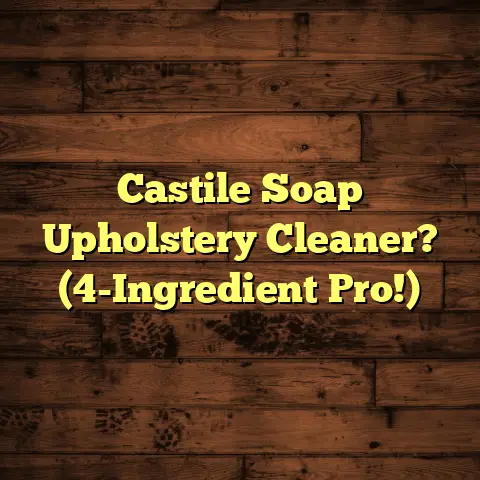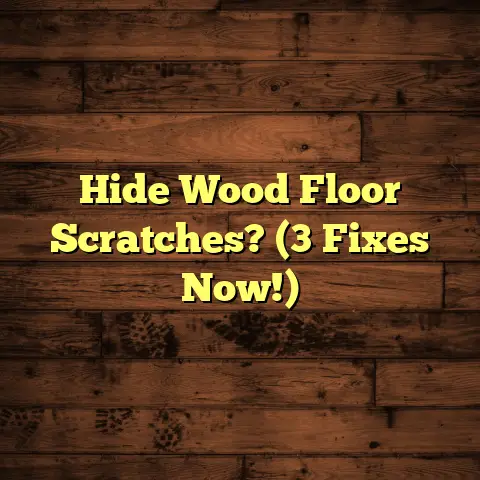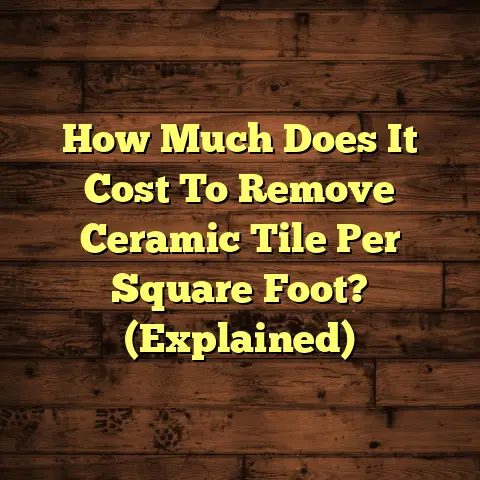Anti-Fatigue Mats Safe on Hardwood? (4 Risks Exposed!)
As a flooring contractor, I’ve spent years knee-deep in sawdust and surrounded by beautiful hardwood.
I get it – comfort is king, especially if you’re standing for long periods.
Whether you’re a chef whipping up culinary masterpieces, a cashier ringing up customers, or just someone who loves spending time in their kitchen, standing for hours can be a real pain.
That’s where anti-fatigue mats come in.
These mats promise relief, improved posture,
and reduced strain.
Sounds great, right?
But before you rush out and buy one, let’s
talk hardwood.
Specifically, are anti-fatigue mats safe to
use on those gorgeous floors?
The answer, my friends, isn’t as simple as a yes or no.
There are some hidden risks you need to know about – risks that can lead to scratches, slipping, mold, and even damage to your floor’s finish.
In this article, I’m going to pull back the curtain and expose the four biggest risks of using anti-fatigue mats on hardwood.
Trust me, you’ll want to read this before you commit!
Understanding Anti-Fatigue Mats
Okay, let’s start with the basics. What are anti-fatigue mats, anyway?
Simply put, they’re mats designed to reduce fatigue caused by prolonged standing.
Think of them as little cushions for your feet, absorbing the impact and encouraging subtle movement that helps improve circulation.
You’ll find them everywhere: kitchens, offices, factories, even hair salons.
They’re a popular solution for anyone who spends a lot of time on their feet.
Types of Anti-Fatigue Mats
Now, not all anti-fatigue mats are created equal.
There are different materials and designs out there,
each with its own pros and cons.
Foam Mats: These are usually the most affordable option.
They’re lightweight and offer decent cushioning.However, they can compress over time and may not be as durable as other types.
* Gel Mats: Gel mats are known for their superior cushioning.
They conform to the shape of your feet, providing excellent support.They tend to be more expensive than foam mats.
* Rubber Mats: Rubber mats are incredibly durable and resistant to wear and tear.They’re often used in industrial settings where heavy-duty performance is required.
* Combination Mats: Some mats combine different materials, such as a foam core with a rubber surface, to offer a balance of comfort and durability.
The thickness and texture of the mat also play
a role.
Thicker mats generally provide more
cushioning, while textured surfaces can improve
traction and prevent slipping.
In my experience, the best type of mat depends on your specific needs and budget.
For home use, a gel or combination mat might be a good choice.
For a busy commercial kitchen, a durable rubber mat is probably the way to go.
Benefits of Using Anti-Fatigue Mats
So, why are anti-fatigue mats so popular? Well, the benefits are pretty compelling.
Reduced Fatigue: This is the big one.
By providing cushioning and encouraging movement, these mats can significantly reduce fatigue and discomfort.A study published in the journal Applied Ergonomics found that using anti-fatigue mats reduced muscle fatigue by up to 50%.
(Source: Applied Ergonomics, Volume 43, Issue 6, September 2012, Pages 1094-1100) * Improved Comfort: Let’s face it, standing on a hard floor all day is just plain uncomfortable.
Anti-fatigue mats make a world of difference.
* Increased Productivity: When you’re not constantly battling fatigue and discomfort, you’re more likely to be productive.Some studies have even shown that using anti-fatigue mats can lead to a noticeable boost in employee output.
* Better Overall Health: Prolonged standing can lead to a variety of health problems, including back pain, joint pain, and poor circulation.Anti-fatigue mats can help alleviate these issues and promote better overall health.
Okay, so anti-fatigue mats are great for your
body.
But what about your hardwood floors?
That’s where things get a little tricky.
Risks of Using Anti-Fatigue Mats on
Hardwood Floors
Alright, let’s get down to the nitty-gritty.
Here are the four biggest risks of using
anti-fatigue mats on hardwood floors:
Risk 1: Potential Damage to Hardwood Flooring
This is probably the most obvious risk, but it’s worth exploring in detail.
Certain materials used in anti-fatigue mats can cause scratches, dents, or other damage to hardwood floors.
Think about it: you’re placing a relatively heavy object on a surface that’s designed to be beautiful and durable, but not necessarily indestructible.
So, what types of mats are more likely to cause damage?
Mats with Abrasive Backings: Some mats have rough or abrasive backings that can scratch the floor as they’re moved or shifted.
This is especially true if the mat is placed in a high-traffic area where it’s likely to be dragged around.
* Mats with Hard Edges: Mats with sharp or rigid edges can dent the floor if they’re dropped or if heavy objects are placed on them.
* Mats That Trap Dirt and Debris: Over time, dirt and debris can accumulate underneath the mat.As you walk on the mat, these particles can grind against the floor, causing scratches and dulling the finish.
The mechanism behind this risk is pretty simple: the weight of the mat, combined with the abrasiveness of the material, creates friction that damages the floor’s surface.
I’ve seen cases where mats have left permanent scratches and dents on hardwood floors, requiring costly repairs or even complete floor replacements.
To minimize this risk, look for mats with smooth, non-abrasive backings.
Also, be sure to regularly clean underneath the mat to remove any dirt or debris.
Consider using a rug pad specifically designed
for hardwood floors.
These pads provide a
cushion between the mat and the floor,
reducing the risk of scratches and dents.
Risk 2: Slipping Hazards and Stability Issues
Okay, so you’re trying to improve your comfort
and reduce fatigue.
The last thing you want
is to end up flat on your back because your
mat slipped out from under you!
Unfortunately, this is a real risk with some anti-fatigue mats, especially on hardwood floors.
Hardwood floors are naturally smooth and slippery, and some mats just don’t have enough grip to stay in place.
Factors that contribute to slippage include:
- The Mat’s Texture: Mats with smooth or slick surfaces are more likely to slip than those with textured surfaces.
- The Floor’s Finish: Floors with glossy finishes tend to be more slippery than those with matte finishes.
- Moisture: Even a small amount of moisture can make a mat more likely to slip.
- The Mat’s Weight: Lighter mats are more likely to move around than heavier mats.
The consequences of a slipping mat can be serious.
Falls are a leading cause of injury, especially
among older adults.
According to the CDC, more than one in four
older adults falls each year in the United States.
(Source: Centers for Disease Control and
Prevention, Falls Among Older Adults)
And while I don’t have specific statistics on falls caused by anti-fatigue mats, I can tell you that I’ve seen it happen.
I once had a client who tripped over a slipping mat in her kitchen and broke her wrist.
It was a painful reminder of the importance of choosing a mat that’s both comfortable and safe.
To prevent slipping, look for mats with non-slip
backings.
These backings are typically made
of rubber or other materials that provide a
strong grip on the floor.
You can also use rug tape or rug grippers to secure the mat to the floor.
Just be sure to choose a product that’s specifically designed for hardwood floors to avoid damaging the finish.
Risk 3: Moisture and Mold Growth
This is a risk that many people don’t even think about, but it’s a serious one.
Moisture can accumulate underneath anti-fatigue mats, especially in humid environments, leading to mold and mildew growth.
Think about it: you’re placing a non-breathable mat on a surface that’s already susceptible to moisture damage.
Any spills, leaks, or even just condensation can get trapped underneath the mat, creating the perfect breeding ground for mold.
The implications of mold growth are far-reaching.
It can damage your hardwood floors, causing
staining, warping, and even rot.
It can also pose a serious health risk, especially for people with allergies or asthma.
Mold spores can trigger allergic reactions, respiratory problems, and other health issues.
I’ve seen cases where mold growth under mats has caused extensive damage to hardwood floors, requiring costly remediation and repairs.
To prevent moisture and mold growth, take these precautions:
- Choose a Breathable Mat: Look for mats made of breathable materials that allow air to circulate.
- Clean Up Spills Immediately: Wipe up any spills or leaks as soon as they happen.
- Ventilate the Area: Make sure the area around the mat is well-ventilated.
- Regularly Clean Under the Mat: Lift the mat and clean underneath it regularly to remove any moisture or debris.
Consider using a dehumidifier to reduce the humidity in your home.
Risk 4: Chemical Reactions and Floor Finish Damage
This is a more subtle risk, but it’s still important to be aware of.
Certain materials used in anti-fatigue mats can react with the finish of hardwood floors, causing discoloration or degradation.
The chemicals in some mats can leach out and interact with the chemicals in the floor finish, leading to a variety of problems.
Which types of materials are most likely to cause this type of damage?
Mats Made with PVC: PVC (polyvinyl chloride) is a common material used in anti-fatigue mats.
However, it can release chemicals that can damage the finish of hardwood floors.
* Mats with Rubber Backings: Some rubber backings contain chemicals that can cause discoloration or staining.
* Mats with Dyes or Pigments: The dyes and pigments used to color mats can sometimes leach out and stain the floor.
I’ve seen cases where mats have caused yellowing, fading, or even peeling of the floor finish.
This type of damage can be difficult to repair and may require refinishing the entire floor.
To minimize this risk, look for mats that are labeled as “floor-safe” or “non-staining.”
Choose mats made with natural rubber or other materials that are less likely to react with the floor finish.
You can also place a barrier between the mat and the floor, such as a piece of felt or a rug pad.
Real-Life Examples and Case Studies
Okay, so I’ve given you the theoretical risks.
Now, let’s talk about some real-life examples.
I’ve seen firsthand the damage that anti-fatigue mats can cause to hardwood floors.
One client of mine, Sarah, had a beautiful
oak floor in her kitchen.
She bought an
anti-fatigue mat to make standing at the sink
more comfortable.
After a few months, she noticed that the floor underneath the mat was discolored.
The finish had started to peel away, leaving a dull, unsightly patch.
It turned out that the mat was made with PVC, and the chemicals in the PVC had reacted with the floor finish.
Sarah was devastated.
She had to refinish her
entire kitchen floor, which cost her thousands
of dollars.
Another client, John, had a different problem.
He bought a rubber mat for his office to
reduce fatigue while he was working at his
standing desk.
The mat seemed fine at first, but after a few weeks, he started to notice a musty smell in the office.
He lifted the mat and discovered a patch of mold growing underneath.
The mold had spread to the hardwood floor, causing staining and damage.
John had to hire a professional mold remediation company to clean up the mess, which was both expensive and time-consuming.
These are just two examples of the many problems that can arise from using anti-fatigue mats on hardwood floors.
I’ve also heard stories from other contractors about slipping accidents, scratched floors, and other issues.
The bottom line is that these risks are real, and you need to be aware of them before you decide to use an anti-fatigue mat on your hardwood floors.
Conclusion
Alright, we’ve covered a lot of ground here. Let’s recap the key points:
- Anti-fatigue mats can be a great way to reduce fatigue and improve comfort when you’re standing for long periods.
- However, they can also pose risks to your hardwood floors.
- The four biggest risks are: potential damage to the floor, slipping hazards, moisture and mold growth, and chemical reactions with the floor finish.
So, what’s the takeaway? Should you avoid using anti-fatigue mats on hardwood floors altogether?
Not necessarily. But you need to be smart about it.
Choose your mat carefully, taking into account the materials it’s made of, the type of backing it has, and the potential for chemical reactions.
Take precautions to prevent slipping, moisture accumulation, and other problems.
And most importantly, be aware of the risks and take them seriously.
Ultimately, the decision of whether or not to use an anti-fatigue mat on your hardwood floors is a personal one.
You need to weigh the benefits against the risks and decide what’s best for you and your home.
But whatever you decide, I hope this article has given you the information you need to make an informed choice.
Thanks for reading, and happy flooring!





